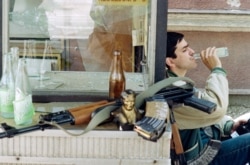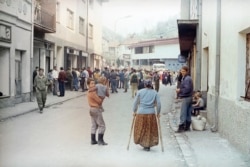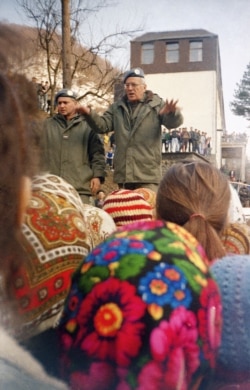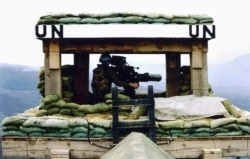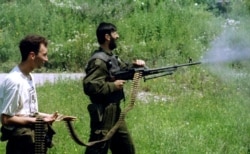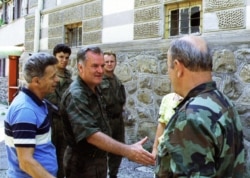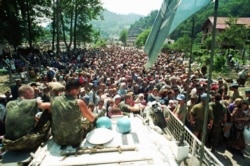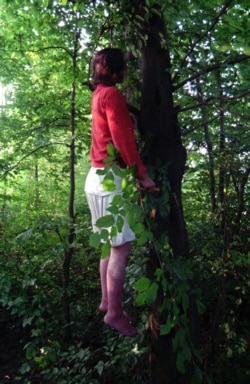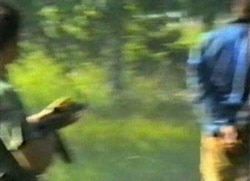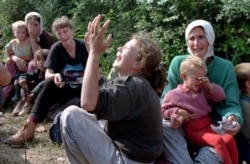Beginning in the spring of 1992, Bosnia-Herzegovina was a country at war -- part of the bloody breakup of the former Yugoslavia along largely ethnic lines. A former province of the Ottoman Empire, multiethnic Bosnia was made up of predominantly Muslim Bosniaks (44 percent), Orthodox Christian Serbs (33 percent), and mainly Catholic Croats (17 percent).
The ferocity of the conflict in Bosnia-Herzegovina uncorked ethnic tensions. In March 1992, Croat and Bosniak fighters killed dozens of civilians in the Bosnian Serb village of Sijekovac in the first massacre of the conflict.
After Bosnian Serb forces seized control of much of the country, Srebrenica (pictured), near the border with Serbia, became a refuge for Muslim civilians fleeing the surrounding Serb-held areas and a base for Bosnian Army fighters.
The Bosniak enclave was strategically important for the Bosnian Serb army that sought to create a continuous swathe of Serb territory in eastern Bosnia up to the border with Serbia.
As surrounding Serb forces rained artillery down on the town and cut off supplies, Bosniak fighters attacked neighboring Serb villages and launched counteroffensives.
In March 1993, UN Protection Force Commander (UNPROFOR) Philippe Morillon talked his way through a Serb blockade and entered Srebrenica. He was then prevented from leaving by crowds of refugees in the town who thronged his vehicle. One woman shouted through Morillon’s car window: “Why is the world not ashamed? Why should you go home? I haven’t been home for a year.”
Morillon gave up on leaving and, in a bleakly comical move, the Frenchman appeared with a loudspeaker next to a fluttering UN flag to announce he had “now decided to stay here in Srebrenica.” Using a phrase that would come to haunt the world, Morillon then declared to the cheering crowd, “You are now under the protection of the United Nations.”
The UN then declared Srebrenica a “safe area” and Bosnian Serb forces vowed not to overrun the enclave on the condition that Bosniak fighters in Srebrenica surrender their weapons.
But in early July, Serbs launched an artillery barrage on the enclave. Bosniak fighters desperately called for a return of their weapons but UN peacekeepers refused as Serb forces advanced on the town.
On July 10, a Dutch UN commander in Srebrenica requested air strikes to halt the Serb attack but was told he had used the wrong document. By the time the right form was filled out by the desperate Dutch commander, the circling jets had run low on fuel and returned to their base in Italy. On July 11, UN troops were brushed aside by Serb forces advancing into Srebrenica. Mladic declared: “Finally, the moment has come for us to take revenge on the Turks in this area.”
One Dutch UN soldier was killed during the Serb advance, apparently with a grenade thrown by a furious Bosniak as retreating UN troops gave up the town.
On July 13, some 20,000 civilians of Srebrenica fled 6 kilometers north to Potocari, where Dutch UN troops were headquartered.
But Serb fighters soon arrived and began mingling with the desperate crowd, pulling men away from their families and taking them away in trucks, while others were led away to immediate execution.
An UNPROFOR commander recalled that the refugees in Potocari “were panicked, they were scared, and they were pressing each other against the soldiers, my soldiers, the UN soldiers that tried to calm them.”
Meanwhile, some 15,000 Srebrenica men, including fighters who knew they would not survive if they were captured, were marching through the forest in an attempt to reach Bosniak-held territory to the north. Many were killed as they were hunted down by Serb forces equipped with armored vehicles and heavy machine guns. Those who surrendered were executed and many were buried in mass graves. Others killed themselves to avoid capture.
Some of the only video footage that exists of the desperate Srebrenica men shows the moment a man surrenders and is asked by the cameraman if he is scared. “How could I not be?” the man responds as he is led away.
According to the Institute for Missing Persons of Bosnia-Herzegovina, more than 8,000 people were killed in the Srebrenica massacre. The remains of some 6,955 people have been identified and reburied.





